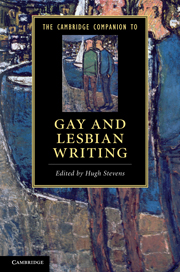Book contents
- Frontmatter
- Homosexuality and literature: an introduction
- Part I Repression and Legitimation
- 1 Homosexual writing on trial: from Fanny Hill to Gay News
- 2 Psychoanalysis, homosexuality and modernism
- 3 Lesbian modernism: writing in and beyond the closet
- 4 The erotics of transgression
- 5 Normality and queerness in gay fiction
- Part II Affiliations
- Part III Literary Traditions
- Guide to further reading
- Index
5 - Normality and queerness in gay fiction
from Part I - Repression and Legitimation
Published online by Cambridge University Press: 28 January 2011
- Frontmatter
- Homosexuality and literature: an introduction
- Part I Repression and Legitimation
- 1 Homosexual writing on trial: from Fanny Hill to Gay News
- 2 Psychoanalysis, homosexuality and modernism
- 3 Lesbian modernism: writing in and beyond the closet
- 4 The erotics of transgression
- 5 Normality and queerness in gay fiction
- Part II Affiliations
- Part III Literary Traditions
- Guide to further reading
- Index
Summary
In 1955 the British journalist and playwright Peter Wildeblood explained in Against the Law, an apologia pro vita sua he wrote after serving a prison sentence in HM Prison Wormwood Scrubs for homosexual offences, that society should tolerate good homosexuals like himself, but not 'the pathetically flamboyant pansy with the flapping wrists . . . corrupters of youth, not even the effeminate creatures who love to make an exhibition of themselves'. Wildeblood's argument for tolerance works by opposing a notion of decent homosexuality, which he believes should be legitimized, to demonized constructions of homosexuality - the elderly predator, the effeminate queen - from which he distances himself. This kind of opposition is precisely the kind of gesture challenged by 'queer' theory and activism. Although 'queer' became popular as a category in American lesbian and gay politics and scholarship in the early 1990s, the conflicts the term addressed have a long history in lesbian and gay culture. Formerly a term of abuse, 'queer' began to be used by lesbians and gay men to describe themselves. Used as a self-description, queer re-emphasized the dissident and subversive potential of gay and lesbian identities, and embraced elements of sexual culture, such as drag, fetishism, sadomasochism and cruising, which mainstream lesbian and gay politics were seen as disavowing.
- Type
- Chapter
- Information
- The Cambridge Companion to Gay and Lesbian Writing , pp. 81 - 96Publisher: Cambridge University PressPrint publication year: 2010



